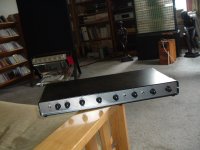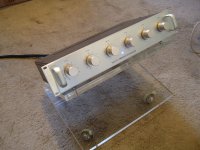Hi,
Sure, go for it. As it say's in the Nike Add's - Just do it!
Ciao T
What did you think of my highly doable economy version ideas at post 86?
Sure, go for it. As it say's in the Nike Add's - Just do it!
Ciao T
SO, that's where it died? Lots of big iron transformers plus a few tubes at a lot of expense for a little job? It looks like personal preferences polluted this project and turned it into (#^@&*!!!) something applicable to only a few people. Why not learn from that, and re-do it in a more efficient way that would be more widely applicable?
Otherwise, I dislike the wild goose chase.
Otherwise, I dislike the wild goose chase.
There is enough information for anyone to go ahead as he see fits.
I don't see why it has to be a common solution for all.
This is called DIY after all.
Patrick
I don't see why it has to be a common solution for all.
This is called DIY after all.
Patrick
Hi Thorsten!Folks,
I had the chance today to run the "ZenEQ" concept through Tina-Ti. This is not necessarily meant to be a final design, rather a quick study how a simple circuit may perform.
This reminded me that if we require a more or less proportionate boost in dB vs. rotation we need to use potentiometers that are "S" curve, not linear. These are hard to get these days.
If using linear pots then the adjustment range gets bunched up towards the extremes. This is not necessarily a bad thing, as it makes very small adjustments very precise, the downside is that if we need a lot of correction we are left with very little usable travel.
If using switches as controls this is of course of no consequence at all, as we simply can select the correct resistances to give correct dB/vs. Attenuation.
Attached is Tina-Ti File I used (needs latest version) and some simulation results, all using 10K//1nF load. I am not sure how accurate the models buld into Tina-Ti are etc., but it would seem okayish for ballpark.
I would specify 2SK170 BL or V for the circuit, Tina-Ti lacks the model, so I made up a compound from 2N3819 & a PNP BJT, 2SK170 will show worse THD. I am for now showing ideal chokes, they can be replaced by gyrators, but I lack the time right now. For the LF choke 2H with < 120 Ohm DCR are needed, I do have a few such around, so we know they can be made.
The schematic looks like this:
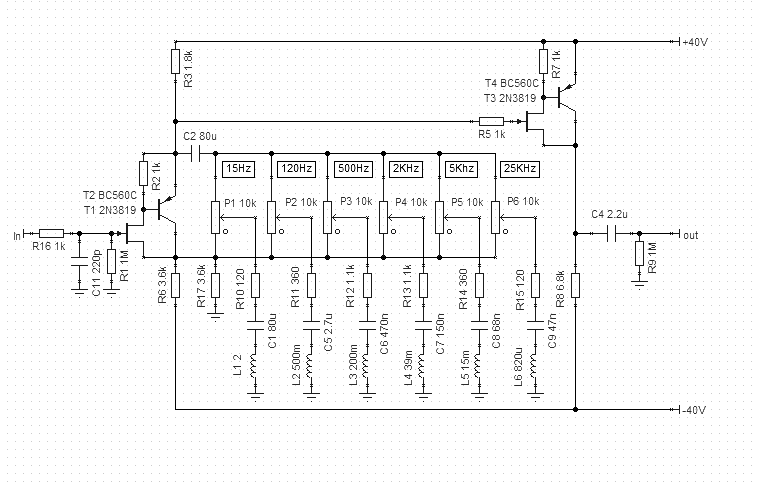
The curves produced by stepping the pots in 10% intervals (this is equivalent to rotating linear pots 10% of the rotation for each step):
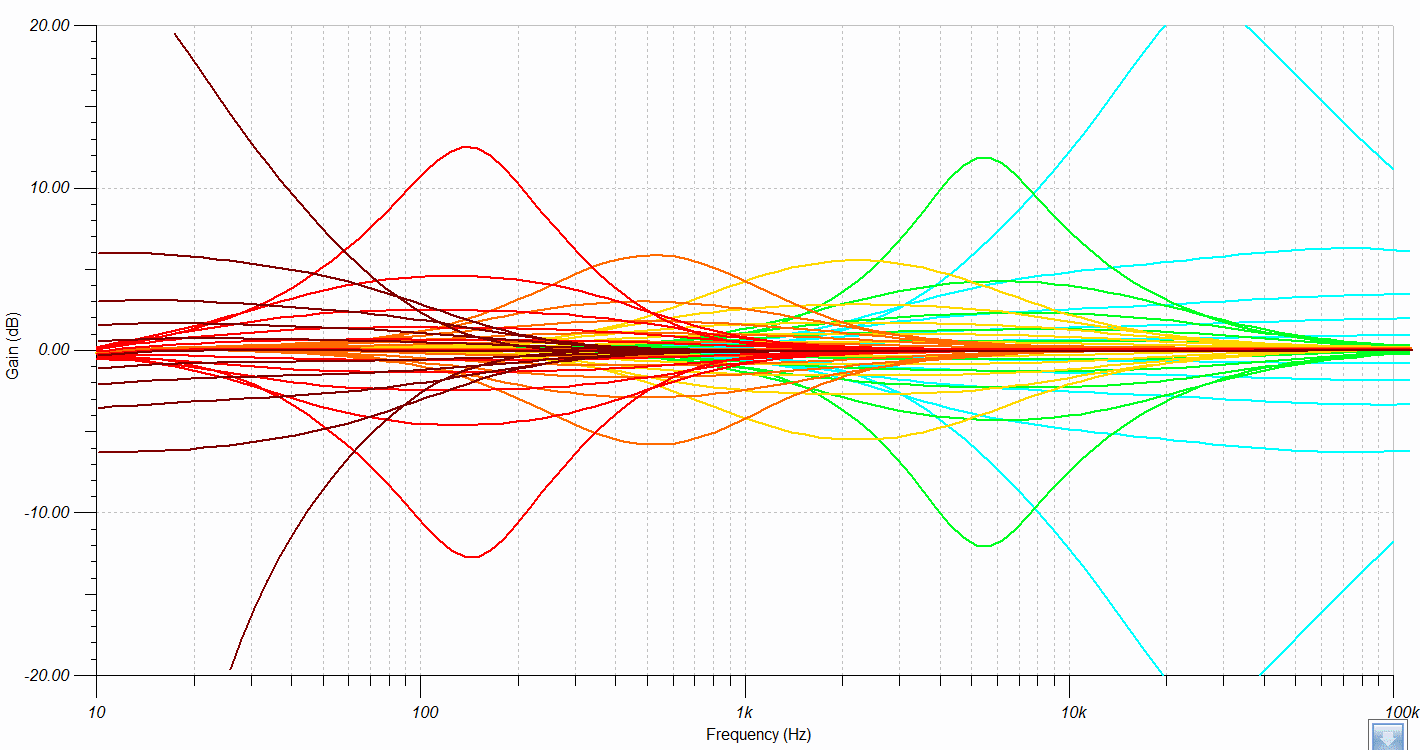
The frequency response with controls perfectly centred (impossible with pots) looks like this:
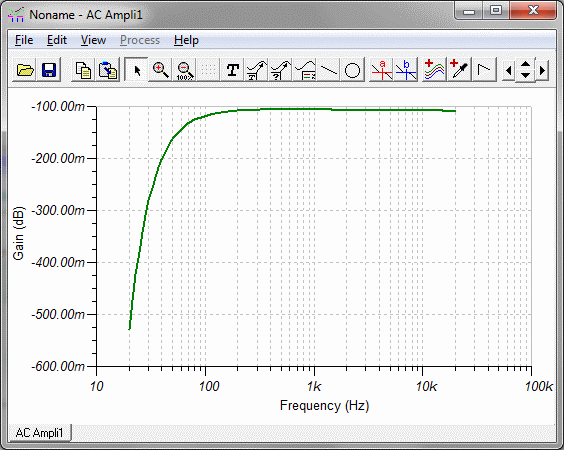
The LF rolloff is a result of the 2.2uF coupling capacitors shown. I habitually use this value, it works fine IME.
To illustrate two interesting EQ results, here what it looks like with all controls set halfway towards maximum cut from neutral:
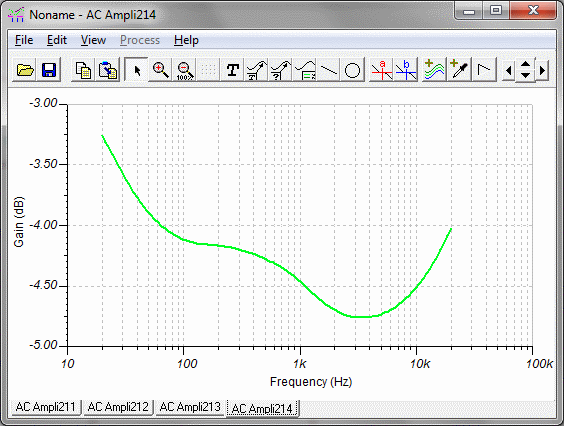
This illustrates rather well how the various bands combine and with a weighting that is similar to the ISO Equal loudness peaks and through...
And here a EQ setting that can help with modern overproduced recordings, by cutting back presence and "kick" bass, and dialing the extremes up, all just a touch:
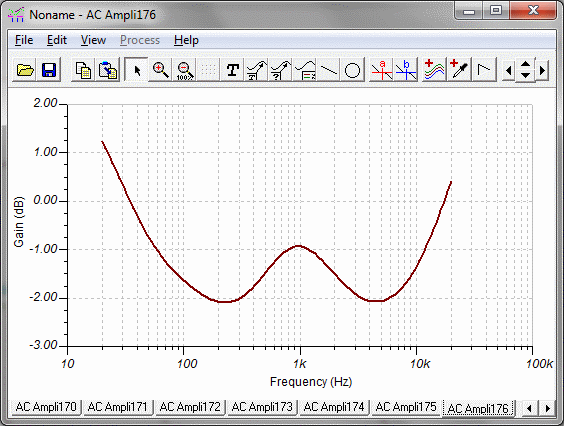
The required pot settings for this (0 = centre, 0.5 is half way between zero and the respective end, linear pots assumed) are:
15Hz = +0.5
120Hz = -0.5
500Hz = +0.2
2KHz = 0.0
5KHz = -0.8
20KHz = +0.6
Here harmonics for 1V out which adds up to 0.005% THD according to Tina-Ti:
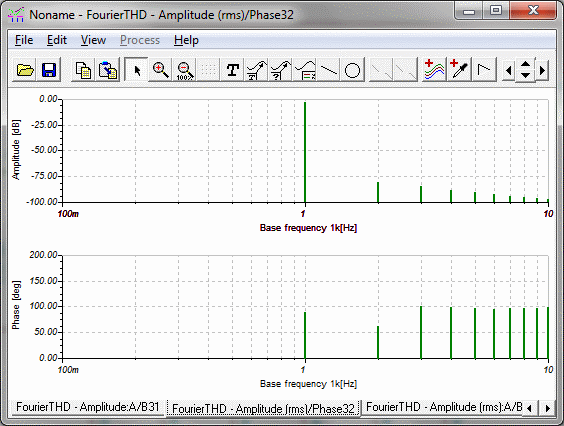
and for 4V out which adds up to 0.05% THD according to Tina-Ti:
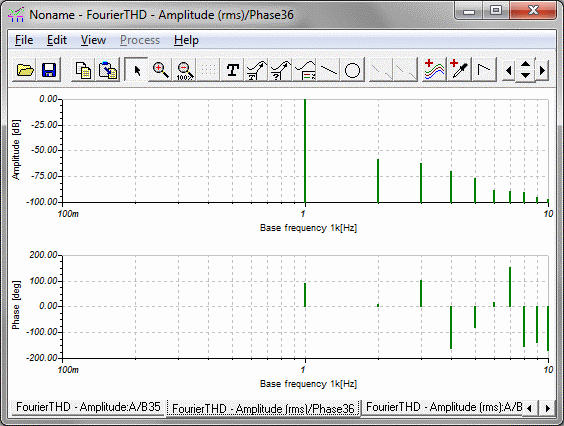
Clipping (1% THD) is at 5V.
Tina-Ti has a seriously funky way of showing noise, anyway, it works out ot -120dB unweighted re. 1V, which seems too good to be true. Still, might be on the money:
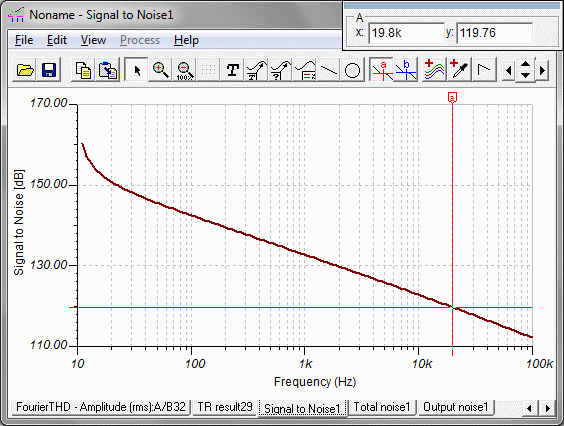
I hope all of this gives people some ideas for the "ZenEQ" and what sort result could be possible, to see if it is worth proceeding. To me the performance looks acceptable, we can get better measured results using Op-Amp's, but I doubt the sound will be improved.
Ciao T
Have you been doing any more work on the final design of the Zen-EQ? Words like ballpark tell me that this is not the final "result".
Personally I would like a tubed version of the Zen-EQ. I have been checking in and reading this thread on a regular basis.. 🙂
-join-
IS this project has even been done by someone? I'm really interested. I nwould like to add control in the bass section, something like 45 hz, 80, hz, 120hz, 200hz. All the bass FREQ could be control with op amps I think with minimal sound quality loss? Can anyone tell me how to do this?
Member
Joined 2009
Paid Member
Projects 149, 150 are more interesting and up to date.
Guitar/Bass Graphic EQ
Parametric EQ
if you can live with opamps. 😉
Patrick
Guitar/Bass Graphic EQ
Parametric EQ
if you can live with opamps. 😉
Patrick
Split-load/Cathodyne/Concertina for EQ
Fascinating circuit! The only similar designs I can think of is in the early Soundcraftsmen 10-band graphic equalizers like the two schematics below. I don't know which one came first, the Soundcraftsmen EQ or the East German EQ. Both from the 70's, I believe.


The only tube version that uses split-load circuit in an EQ I can find is from a Fender guitar amp.

It includes this schematic:
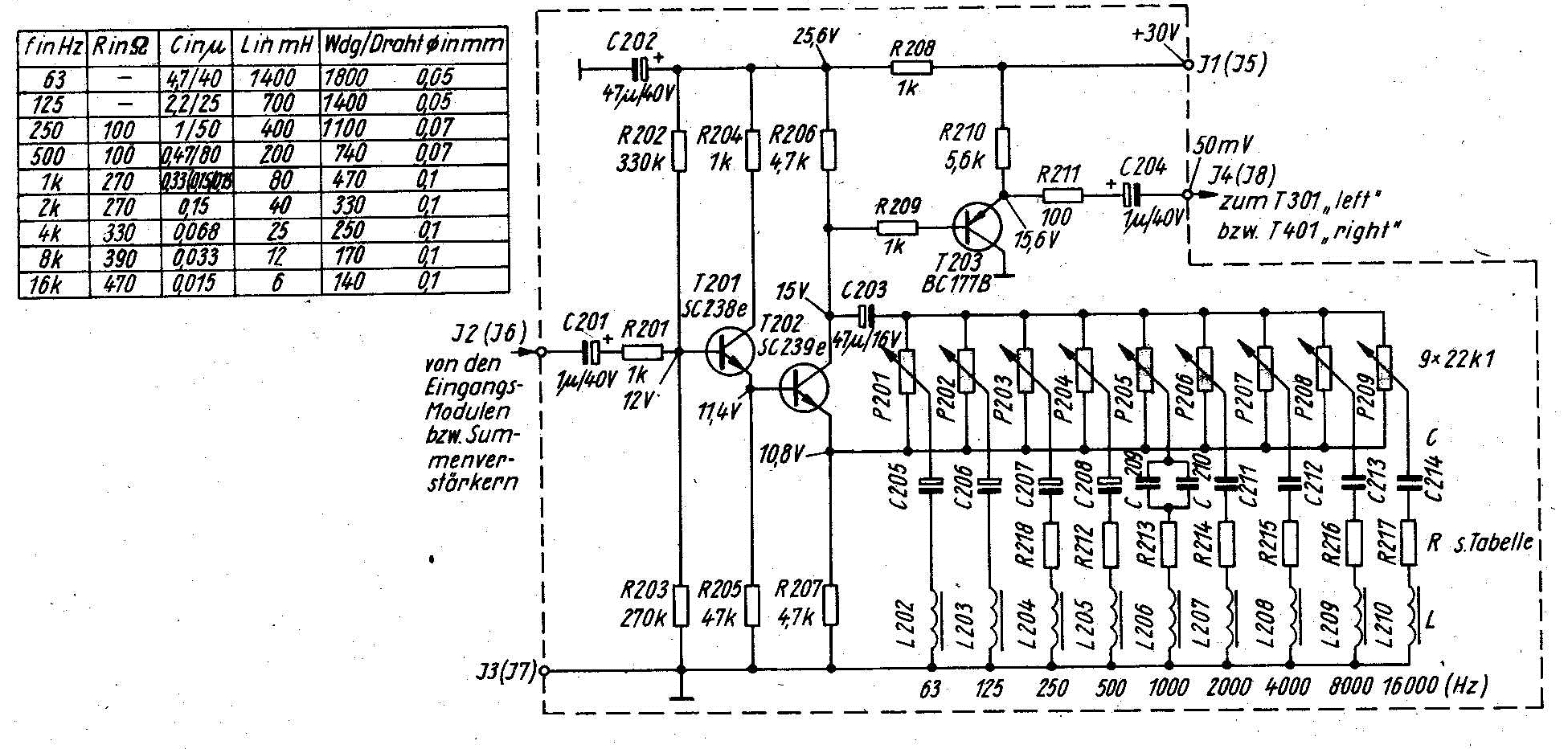
I called it "East German EQ" because that is what it is. It was designed in East Germany in the late 70's and remains somewhat legendary for it's sound quality. It avoids the use of looped feedback, which similar western Pro-Audio design already used in massive amounts routinely. I can attest to the sonics of this type of EQ, I used it extensively.
This EQ shows the principles for what "ZenEQ" (Solid State) and the "HotEQ" (Tubed).
Fascinating circuit! The only similar designs I can think of is in the early Soundcraftsmen 10-band graphic equalizers like the two schematics below. I don't know which one came first, the Soundcraftsmen EQ or the East German EQ. Both from the 70's, I believe.


The only tube version that uses split-load circuit in an EQ I can find is from a Fender guitar amp.

Very nice Peter, that's good info! Do you have any info on the discrete opamps that were used?
Jan
Jan
You are correct. Sorry, I missed those FET pairs at the output and thought they were part of the feedback mechanism but I see there are other FETs to do the feedback for tone shaping. It still would be nice to have midrange, and esp a parametric midrange. And for me, a real board to buy.OK, I get your point.
It becomes part of the filter network.
Patrick
I hate to say this but the original and much admired Cello "Palette" was a right real PIA to use - the 6 low Q filters (Q of 0.7) overlap a lot and it takes a quite a long time to adjust them well even if you have some background in 'pro-audio' - it's not really surprising that it's the simpler tone controls that actually get used in hifi
It also rather interesting that very few of the tone control circuitry used by some of the top quality studio mixer were so rarely used in hifi preamps, even simplified versions redesigned for home hifi use - tone filters from highly regarded Neve, Harrison, Allen/Heath, Soundcraft, etc for example.
A really useful analogue filter, apart from the typical bass & treble, is the old Quad "tilt tone control" - about as simple as it gets - I think a version of this is still available from Glassware Audio - a 'remote control' version would be quite quite handy ...
.
It also rather interesting that very few of the tone control circuitry used by some of the top quality studio mixer were so rarely used in hifi preamps, even simplified versions redesigned for home hifi use - tone filters from highly regarded Neve, Harrison, Allen/Heath, Soundcraft, etc for example.
A really useful analogue filter, apart from the typical bass & treble, is the old Quad "tilt tone control" - about as simple as it gets - I think a version of this is still available from Glassware Audio - a 'remote control' version would be quite quite handy ...
.
The Neve, I'm pretty sure was parametric.It also rather interesting that very few of the tone control circuitry used by some of the top quality studio mixer were so rarely used in hifi preamps, even simplified versions redesigned for home hifi use - tone filters from highly regarded Neve, Harrison, Allen/Heath, Soundcraft, etc for example.
A really useful analogue filter, apart from the typical bass & treble, is the old Quad "tilt tone control" - about as simple as it gets - I think a version of this is still available from Glassware Audio - a 'remote control' version would be quite quite handy ...
.
I also agree that a simple tilt control would be great. The Glassware Audio had a simple one but it is purely passive so one needs to add buffer on output at minimum when integrating it into gear, which is why a nice PCB with the tone control circuitry and buffers on input and output would be great for this DIY. I also remember that Audio Amateur published an article by Reg Williamson that had a version of the Quad tilt control implemented through active circuity. I have pdf of a scan of that article. I can post it if DIY Audio can get permission. In the meantime, anyone who wants a copy please PM me and I will email you the copy.
The Quad Artera Pre https://www.quad-hifi.co.uk/artera-pre/ has re-introduced the tilt control. It is menu driven, so the tilt is nothing like as easy to control as the original 34 and 44 preamps, but at least it is there https://theaudiophileman.com/artera-pre-amplifier-news-quad-tilt/
For anyone who wants to know the history of tone controls, including the history of the tilt control (it goes back further than you might think), this is the go-to thread https://www.vintage-radio.net/forum/showthread.php?t=156244
Incidentally the Burwen description of the op-amp based Cello that he did for them actually has a four band Cello-like EQ, and effectively a Baxandall style tone control. When Cello re-engineered the design around discrete amps, they ditched the Baxandall part and introduced two additional low Q bands instead.
Incidentally the Burwen description of the op-amp based Cello that he did for them actually has a four band Cello-like EQ, and effectively a Baxandall style tone control. When Cello re-engineered the design around discrete amps, they ditched the Baxandall part and introduced two additional low Q bands instead.
Guys,
Would like to comment on the boost/cut levels proposed in various posts.
I've built up a few of the Palette Preamp Equalizer section from the original schematics. Used them a lot and came to some conclusions about the amounts of boost/cut actually needed.
Please remember that the Cello was designed to be a PROGRAM equalizer. Not a ROOM equalizer. As such, the amount of boost/cut NEEDED in the mid frequencies, combined with the ear's sensitivity at those frequencies, appears to be much less than at the frequency extremes.
Still using the same basic 6 frequencies as the original Palette, but now use boost / cut values of +-12dB at 20hx and 20K; +- 8dB at 120hz and 5K; and (only)+-4 dB at 400/800 hz (switchable) and +- 4db @1K/2Khz (again switchable.
Did put the Equalizer section in a nice small box (see Pictures of 2 versions) on the end of a 10M umbilical that plugs into my DIY Cello Encore Line Stage. Can dial-in the EQ; adjust the gain of each channel by 3dB or so and defeat the equalization FROM the LISTENING POSITION.
Use it a lot to "tame" bright CD's and "boost" deficient bass on older LP's. Amazingly, in many cases only ONE to TWO dB is all that is needed in the midrange.
Would like to comment on the boost/cut levels proposed in various posts.
I've built up a few of the Palette Preamp Equalizer section from the original schematics. Used them a lot and came to some conclusions about the amounts of boost/cut actually needed.
Please remember that the Cello was designed to be a PROGRAM equalizer. Not a ROOM equalizer. As such, the amount of boost/cut NEEDED in the mid frequencies, combined with the ear's sensitivity at those frequencies, appears to be much less than at the frequency extremes.
Still using the same basic 6 frequencies as the original Palette, but now use boost / cut values of +-12dB at 20hx and 20K; +- 8dB at 120hz and 5K; and (only)+-4 dB at 400/800 hz (switchable) and +- 4db @1K/2Khz (again switchable.
Did put the Equalizer section in a nice small box (see Pictures of 2 versions) on the end of a 10M umbilical that plugs into my DIY Cello Encore Line Stage. Can dial-in the EQ; adjust the gain of each channel by 3dB or so and defeat the equalization FROM the LISTENING POSITION.
Use it a lot to "tame" bright CD's and "boost" deficient bass on older LP's. Amazingly, in many cases only ONE to TWO dB is all that is needed in the midrange.
Attachments
- Home
- Source & Line
- Analog Line Level
- Cello Palette Style EQ Design (was High End Tone Control)...
